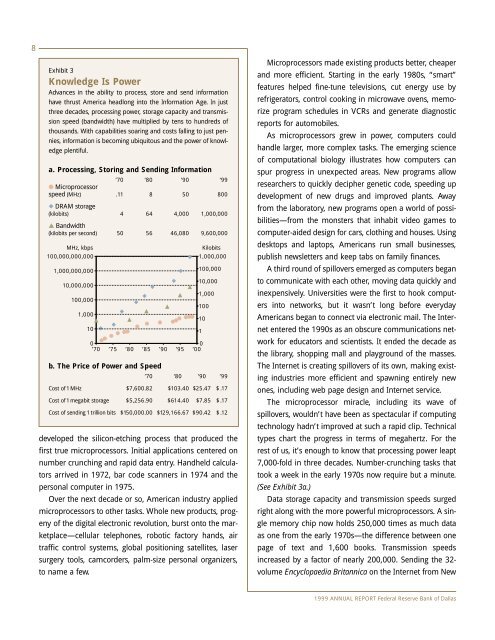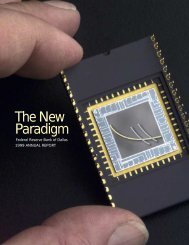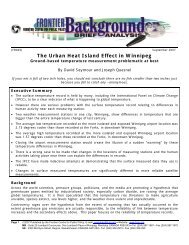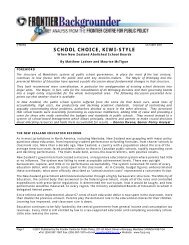The New Paradigm - Federal Reserve Bank of Dallas
Create successful ePaper yourself
Turn your PDF publications into a flip-book with our unique Google optimized e-Paper software.
8<br />
Exhibit 3<br />
Knowledge Is Power<br />
Advances in the ability to process, store and send information<br />
have thrust America headlong into the Information Age. In just<br />
three decades, processing power, storage capacity and transmission<br />
speed (bandwidth) have multiplied by tens to hundreds <strong>of</strong><br />
thousands. With capabilities soaring and costs falling to just pennies,<br />
information is becoming ubiquitous and the power <strong>of</strong> knowledge<br />
plentiful.<br />
a. Processing, Storing and Sending Information<br />
’70 ’80 ’90 ’99<br />
● Microprocessor<br />
speed (MHz) .11 8 50 800<br />
◆ DRAM storage<br />
(kilobits) 4 64 4,000 1,000,000<br />
▲ Bandwidth<br />
(kilobits per second) 50 56 46,080 9,600,000<br />
MHz, kbps<br />
Kilobits<br />
100,000,000,000 1,000,000<br />
1,000,000,000<br />
100,000<br />
10,000<br />
10,000,000<br />
1,000<br />
100,000<br />
100<br />
1,000<br />
10<br />
10<br />
1<br />
0 ●● ● ● ●● ● ● ● ●● ● ● ●<br />
0<br />
’70 ’75 ’80 ’85 ’90 ’95 ’00<br />
b. <strong>The</strong> Price <strong>of</strong> Power and Speed<br />
’70 ’80 ’90 ’99<br />
Cost <strong>of</strong> 1MHz $7,600.82 $103.40 $25.47 $.17<br />
Cost <strong>of</strong> 1megabit storage $5,256.90 $614.40 $7.85 $.17<br />
Cost <strong>of</strong> sending 1trillion bits $150,000.00 $129,166.67 $90.42 $.12<br />
developed the silicon-etching process that produced the<br />
first true microprocessors. Initial applications centered on<br />
number crunching and rapid data entry. Handheld calculators<br />
arrived in 1972, bar code scanners in 1974 and the<br />
personal computer in 1975.<br />
Over the next decade or so, American industry applied<br />
microprocessors to other tasks. Whole new products, progeny<br />
<strong>of</strong> the digital electronic revolution, burst onto the marketplace—cellular<br />
telephones, robotic factory hands, air<br />
traffic control systems, global positioning satellites, laser<br />
surgery tools, camcorders, palm-size personal organizers,<br />
to name a few.<br />
Microprocessors made existing products better, cheaper<br />
and more efficient. Starting in the early 1980s, “smart”<br />
features helped fine-tune televisions, cut energy use by<br />
refrigerators, control cooking in microwave ovens, memorize<br />
program schedules in VCRs and generate diagnostic<br />
reports for automobiles.<br />
As microprocessors grew in power, computers could<br />
handle larger, more complex tasks. <strong>The</strong> emerging science<br />
<strong>of</strong> computational biology illustrates how computers can<br />
spur progress in unexpected areas. <strong>New</strong> programs allow<br />
researchers to quickly decipher genetic code, speeding up<br />
development <strong>of</strong> new drugs and improved plants. Away<br />
from the laboratory, new programs open a world <strong>of</strong> possibilities—from<br />
the monsters that inhabit video games to<br />
computer-aided design for cars, clothing and houses. Using<br />
desktops and laptops, Americans run small businesses,<br />
publish newsletters and keep tabs on family finances.<br />
A third round <strong>of</strong> spillovers emerged as computers began<br />
to communicate with each other, moving data quickly and<br />
inexpensively. Universities were the first to hook computers<br />
into networks, but it wasn’t long before everyday<br />
Americans began to connect via electronic mail. <strong>The</strong> Internet<br />
entered the 1990s as an obscure communications network<br />
for educators and scientists. It ended the decade as<br />
the library, shopping mall and playground <strong>of</strong> the masses.<br />
<strong>The</strong> Internet is creating spillovers <strong>of</strong> its own, making existing<br />
industries more efficient and spawning entirely new<br />
ones, including web page design and Internet service.<br />
<strong>The</strong> microprocessor miracle, including its wave <strong>of</strong><br />
spillovers, wouldn’t have been as spectacular if computing<br />
technology hadn’t improved at such a rapid clip. Technical<br />
types chart the progress in terms <strong>of</strong> megahertz. For the<br />
rest <strong>of</strong> us, it’s enough to know that processing power leapt<br />
7,000-fold in three decades. Number-crunching tasks that<br />
took a week in the early 1970s now require but a minute.<br />
(See Exhibit 3a.)<br />
Data storage capacity and transmission speeds surged<br />
right along with the more powerful microprocessors. A single<br />
memory chip now holds 250,000 times as much data<br />
as one from the early 1970s—the difference between one<br />
page <strong>of</strong> text and 1,600 books. Transmission speeds<br />
increased by a factor <strong>of</strong> nearly 200,000. Sending the 32-<br />
volume Encyclopaedia Britannica on the Internet from <strong>New</strong><br />
1999 ANNUAL REPORT <strong>Federal</strong> <strong>Reserve</strong> <strong>Bank</strong> <strong>of</strong> <strong>Dallas</strong>

















